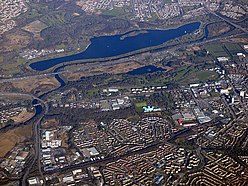| Bothwellhaugh Roman Fort | |
|---|---|
 The fort was located on land which is now to the north of
Strathclyde Loch | |
| Location | |
| Coordinates | 55°47′48″N 4°01′35″W / 55.796699°N 4.026359°W |
| Place name | Strathclyde Country Park |
| County | North Lanarkshire |
| Country | Scotland |
| Reference | |
| UK-OSNG reference | NS731575 |
Bothwellhaugh Roman Fort [1] is a site now located within Strathclyde Country Park in North Lanarkshire, Scotland. It is east of where the South Calder Water flows into Strathclyde Loch. [2] The fort is a scheduled monument. [3]
Location
Before the flooding of Bothwellhaugh village to create the loch, the site overlooked the point where the Roman road bridged the South Calder Water near its confluence with the River Clyde. [4] The Roman Road was known as Watling Street; [5] it is shown on old maps from before the diversion of the Clyde and before the rediscovery of the fort. [6] In terms of large towns the fort is west of Motherwell, to which it is closest, north of Hamilton, and south of Bellshill.
Discovery

Mention of a Roman structure is made in the Dalziel section of the Old Statistical Account. [8] The fort was rediscovered by J. M. Davidson in 1925. [9] The fort was built in a scalene right quadrilateral pattern and was large enough to house both troops and cavalry. [10]
The fort is likely to have been linked by roads to sites on the Antonine Wall and south at Castledykes but exactly how they were connected is a matter of ongoing study. [11]

A Roman bath house [12] was subsequently found between the fort and medieval bridge anachronistically named 'Roman Bridge'. [13] The bath house, which was found in November 1973 beneath a pond, was moved to higher ground in 1980 and is now open to the public. [14] The complete excavation was carried out in 1975-76 under the direction of Lawrence Keppie. [15] The bath house was made up of: a Vestibule, a Frigidarium (cold room with cold plunge bath), a first and second Tepidarium (warm rooms), a Caldarium (hot room with nearby hot bath), and a Praefurnium (furnace room). Perhaps around 20 soldiers at a time could use the bath house. [16]
Hundreds of artifacts were taken from the excavations on the site to the Hunterian Museum at Glasgow University. These include a Roman drain cover slab, [17] a hunt cup, [18] and tile with a paw print. [19] Pottery from the site has established an Antonine occupation but how the site relates to the Antonine Wall remains unclear. [20] The full catalog of the finds is available along with many sketches. [21]
The distance from the thermae (baths) to the fort suggests there are other, as yet undiscovered structures.
See also
- Bearsden Baths (Another nearby Roman site)
References
- ^ "Roman Fort (Roman)". Canmore. Historic Environment Scotland. Retrieved 7 July 2018.
- ^ "OpenStreetMap overlay on historical maps". Map Images. National Library of Scotland. Retrieved 7 July 2018.
- ^ Historic Environment Scotland. "Bothwellhaugh,Roman fort (SM1140)". Retrieved 13 March 2019.
- ^ Maxwell, G. S. (1975). "Excavation at the Roman Fort of Bothwellhaugh, Lanarkshire, 1967-8". Britannia. 6: 20–35. JSTOR 525987.
- ^ Meek, William; Buchan, William (1845). The new statistical account of Scotland (Vol 6 ed.). Edinburgh and London: William Blackwood and Sons. p. 451. Retrieved 3 January 2018.
- ^ "25 inch O.S. map with OpenStreetMap opacity slider". National Library of Scotland. Ordnance Survey. Retrieved 7 July 2018.
- ^ Keppie, Lawrence (1989). "The Romans in Southern Scotland: Future Discoveries". Glasgow Archaeological Journal. 16 (16): 1–27. Retrieved 9 July 2018.
- ^ Clawson, Robert (1792). The Statistical Account of Scotland (Parish of Dalziel) (vol iii ed.). Edinburgh. pp. 454–68. Retrieved 9 July 2018.
- ^ Miller, S. N. (1952). The Roman Occupation Of South Western Scotland Being Reports Of Excavations And Surveys Carried Out Under The Auspices Of The Glasgow Archaeological Society By John Clarke, J. M. Davidson, Anne S. Robertson, J. K. St. Joseph, Edited For The Society With An Historical Survey By S. N. Miller. Glasgow: Robert Maclehose & Company Limited. Retrieved 11 October 2017.
- ^ "Bothwellhaugh Roman Fort". Roman Britain.
- ^ Wilson, Allan (1994). "Roman Penetration in Strathclyde South of the Antonine Wall PART ONE: THE TOPOGRAPHICAL FRAMEWORK". Glasgow Archaeological Journal. 19 (19): 1–30. Retrieved 9 July 2018.
- ^ "Bath House (Roman)". Canmore. Historic Environment Scotland. Retrieved 7 July 2018.
- ^ "Strathclyde Country Park, South Calder Water, Roman Bridge". Canmore. Historic Environment Scotland. Retrieved 7 July 2018.
- ^ Mitchell, Robert (30 June 2017). "Romans march on Strathclyde Park's historic Bathhouse for free fun day this Saturday, July 1". Daily Record. Retrieved 9 July 2018.
- ^ Keppie, L J F (1981). "Excavation of a Roman Bathhouse at Bothwellhaugh, 1975—76". Glasgow Archaeological Journal. 8 (8): 46–94. Retrieved 9 July 2018.
- ^ Keppie, L J F (1981). "Excavation of a Roman Bathhouse at Bothwellhaugh, 1975—76". Glasgow Archaeological Journal. 8 (8): 46–94. Retrieved 9 July 2018.
- ^ "Roman drain cover slab". A History of The World. BBC. Retrieved 7 July 2018.
- ^ "Hunt Cup, Bothwellhaugh Fort". Retrieved 7 July 2018.
- ^ "Tile With Paw Print, Bothwellhaugh Fort". Retrieved 7 July 2018.
- ^ "Discovery and Excavation in Scotland (1968)" (PDF). Archaeology Data Service. Retrieved 7 July 2018.
- ^ Keppie, L J F (1981). "Excavation of a Roman Bathhouse at Bothwellhaugh, 1975—76". Glasgow Archaeological Journal. 8 (8): 46–94. Retrieved 9 July 2018.
External links
![]() Media related to
Bothwellhaugh Roman Fort at Wikimedia Commons
Media related to
Bothwellhaugh Roman Fort at Wikimedia Commons
